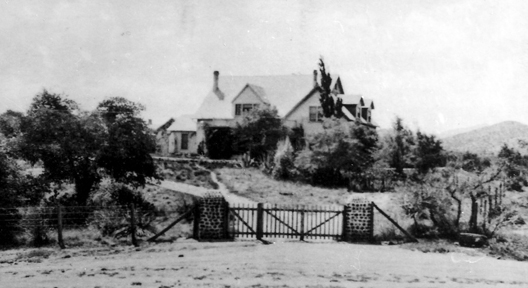A Brief History of Oracle
Drawn from the Acadia Ranch Introductory Exhibit, Early Oracle, Snapshots, which was sponsored by the Arizona Historical Society
How Oracle Got Its Name
Oracle was named in 1878 for a ship built in Bath, Maine. The story goes that Albert Weldon, a west coast prospector, survived a terrible storm off of the Cape of Good Hope on board the very same ship. In gratitude, Weldon named his first mining claim “The Oracle” which the town later adopted as its own.
The First Settlers
As a ‘sky island’ situated at 4,500 feet, Oracle boasts a temperate climate and an array of natural features, such as oak stands, tall grasses, rock outcroppings, canyons, veins of ore and breathtaking views. These features have drawn settlers to the region for over 10,000 years.
The first to arrive were the Hohokam, a large and highly advanced civilization based in and around what is now Tucson and Phoenix. Splinter groups settled the banks of the nearby San Pedro River, which they seasonally farmed, and set up summer camps in the Oracle highlands. Here they hunted, gathered acorns, grasses for weaving baskets and other resources – as the O’odham and Apache do to this day.
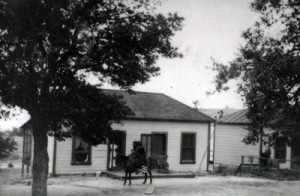
Apache Women in Front of Acadia Cabins, July 1908
Hohokam civilization inexplicably came to an end in the late 15th century. When Father Kino traveled the San Pedro River in 1698, their descendants the Sobaipuris and Apache both had settled the region and were in conflict over it. In time, the Sobapiris relocated to the San Xavier Mission, home to the Tohono O’odham Nation to the south.
Called Apachería by the Spanish, the landscape in the period to follow was marked by constant war. In 1870, a massacre of 200 Apache women, children and elders at Aravaipa Creek by a vigilante band from in and around Tucson resulted in the relocation of the area’s Apache to the San Carlos Reservation. However two prominent Apache families managed to retain title to a portion of their traditional lands.
Homesteads, Health Hotels and Ranches
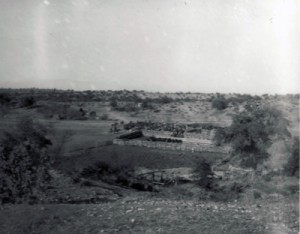
Roundup, 5/5/1909
Pioneers from Mexico and the eastern United States were the first to homestead the same San Pedro River. Often inter-marrying, by the 1880s they had begun establishing sheep and cattle ranches that extended from the Catalinas to the south to the Galiuros east to the Tortolitas to the west and Black Mountain to the north. These early communities were marked by their extraordinary cultural and ethnic diversity.
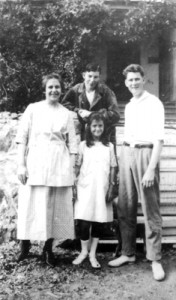
Acadia Steps, Patient and Friends
However, it was at the turn of the last century that Oracle gained international fame as an ideal cure for those suffering from ‘consumption,’ the name given to tuberculosis and other lung afflictions at a time before penicillin. After an article was published in the leading medical journal, many came to Oracle in the belief the fresh air would restore them to good health. The Dodges, who built the Acadia Ranch in the 1880s as a boarding house and sheep ranch, were soon accommodating the ‘lungers.’
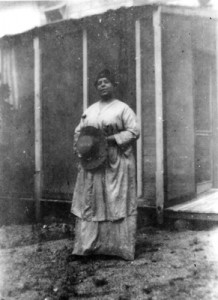
Annie Neal, circa 1920
The Neals, a couple of African American and Cherokee descent, who built the much grander Mountain View Hotel, followed them. The well-heeled clientele included ambassadors, European nobility, business magnates, published writers and artists.
William F. ‘Buffalo Bill’ Cody, who owned mining interests in the area, was a constant visitor at the Mountain View and a close personal friend of William ‘Curly’ Neal. Famed sculptor Alexander Calder and his family stayed for several months at the Acadia when he was a youth.
Dude Ranches
By the 1920s, the health resort hotels were being replaced by the dude ranches, as the invention of penicillin reduced the TB population. Oracle continued to act as a magnet for those lured by the romance of the Western frontier. As Hollywood movies promoted the cowboy myth, it is no wonder that many Hollywood stars came out to Oracle, including Rita Hayworth, Gary Cooper and Tom Mix.
Oracle was also settled by well-known philanthropists the Stewards, who built a two-story adobe manse in the center of the village. During this same period, the architecturally significant Rancho Robles and Kannally Ranch were built and the older Rancho Linda Vista was expanded.
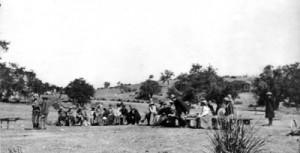
Rancho Linda Vista Rifle Shoot
Rancho Linda Vista may in fact have been the very first Arizona ‘dude ranch’ to cater to the Hollywood crowd, who followed in the wake of the on-location filming of the 1924 silent movie The Mine with the Iron Door. A long-term guest, the era’s most popular author Harold Bell Wright wrote both the film script and original book while staying at Rancho Linda Vista.
The San Manuel Mine
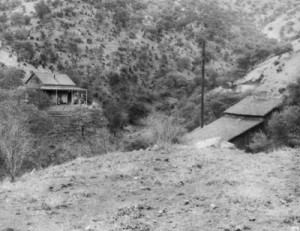
Southern Belle Mine, 3/8/1909
After both the cattle and guest ranch businesses waned, mining became the next big regional industry. While high-yield gold, copper and other mineral mines had long existed at Mammoth and Tiger, the San Manuel Copper Mine, built in 1942, was to become the country’s largest underground copper mine.
The mine hired many of the area’s out-of-work cowboys, and soon became the region’s largest employer. The mine’s smelter was also one of the largest in the world. Bought by BHP, an Australian concern, the mine was closed in 1999 in order to restrict global production. Ironically, within a few years, copper began to command such high prices that new mines are once again being built in Arizona.

